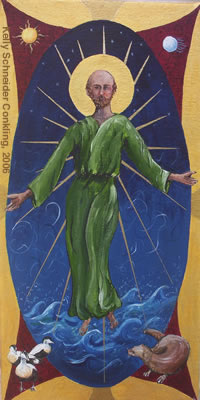
St.
Cuthbert of Lindisfarne
by Mary C.
Earle
Portrait
of Saint Cuthbert by
Kelly Schneider Conkling
With the ebb,
With the flow,
O Thou Triune
Of grace!
With the ebb,
With the flow.
—Carmina
Gadelica, II, 217
Saint Cuthbert lived in the seventh century in the area that is
now northern England and southern Scotland. He lived in a time very
remote from ours, a time so long ago that I doubt we can even imagine
its culture. That said, his time was rife with political and religious
polarities—not so very different from our own
 Struggles
were raging about who was right and who was wrong. The native church
of Celtic Britain had developed practices that differed in form
from those of the church in Rome. Just as in our own times, congregations
and governing church bodies were wracked by heated arguments and
dissent. Struggles
were raging about who was right and who was wrong. The native church
of Celtic Britain had developed practices that differed in form
from those of the church in Rome. Just as in our own times, congregations
and governing church bodies were wracked by heated arguments and
dissent.
Cuthbert
had been formed by the Celtic Christian tradition on the island
of Iona. As a young boy, he had been drawn to the monastic life.
After mentoring and prayer, he became the abbot of the community
at Lindisfarne, also known as Holy Island, on the northeast coast
of the borderlands of Scotland and England.
As an abbot, and later as a bishop, he was known for a remarkable
capacity to act as a reconciler in times of dissent. The many stories,
even the legends, give us a sense of a man who was able to speak
the truth in love, and to guide communities in the midst of turmoil
and confusion.
Cuthbert
was something of an introvert; he was a person whose spirit was
quickened by silence and solitude. As a consequence, he faced a
challenge—how to remain steady in the face of so much contention
within his own community at Lindisfarne and within the larger church.
The
island itself offered the gift of a tidal rhythm. Lindisfarne is
cut off from the mainland twice a day when the tide is full. When
the tidal waters ebb, you can walk from the island to the mainland.
A profound natural rhythm shapes the life of those who live on Lindisfarne
to this day. A full tide enfolds the little island in the waters
of the sea, and for a bit, even the tourists and the pilgrims cannot
reach it. With the ebb, connection is restored and traffic goes
back and forth.
In
Cuthbert’s life we see the example of someone who knows the
need to live out that elemental rhythm, that pattern of community
and solitude, that ebb and flow. One
author suggests that in his life as a bishop, Cuthbert suffered
from what we would call depression, partly because he was not on
the island and could not rest in the silence and solitude that replenished
his spirit. His office demanded a life that was continually engaged
in administration, in public pronouncements, in hearing disputes.
When
he was able to return to the monastic life, he retired to Inner
Farne, an island even more remote than Lindisfarne. Even in this
hermit setting, pilgrims sought him out for counsel. His reputation
for gentle insight and soul-hospitality brought many to his home.
He developed a signal—a shuttered window. If it were closed,
he was to be left in prayer. I am told that in some Native American
cultures similar ways are practiced. An open blind invites a knock
on the door; a closed blind says, “Not now.”
St.
Cuthbert’s life has taught me to tend to both the ebb and
the flow of action, prayer and life itself. Our culture here in
the United States is so over-heated, so noisy, so busy, that we
often make decisions impulsively and without reflection. We often
drive ourselves to exhaustion, and forget why in the world we might
be doing what we are doing. We think of hospitality in odd ways—either
refusing the stranger completely, or thinking in a thoroughly romantic
way that we need to welcome every single person at any time.
Cuthbert’s
life, though remote in time from us, teaches us the deep human need
to allow for rest, replenishing quiet, communion with the natural
world and the time to simply catch up to ourselves. His
life is one of discernible patterns of movement like the tide—hospitality
and seclusion, activity and rest, community and solitude. St. Cuthbert
is dear to me because, though his stories are often embellished,
he comes through as a real human being, dealing with tensions within
himself and within his society.
I am
convinced that beginning to pattern our lives on this ebb and flow
may be the most subversive act that could happen for both persons
and communities. Allowing ourselves to follow Cuthbert’s example
challenges our assumptions of self-importance and our habituated
tendency to over-work.
In
fact, Cuthbert’s life offers us an example of the real fruitfulness
of life that is possible when rest is allowed, when quiet restores
the soul, when stillness gives us the space in which to breathe.
We step away from the harried, hassled, incessant patterns of too
much of everything. As we live with ebb and flow, we allow ourselves
time to be in the garden, to write in the journal, to listen to
God. In that shift, real transformation is possible and deep, lasting
restoration of community and culture may grow up.
With
the ebb,
With the flow,
O thou Triune
Of Grace!
With the ebb,
With the flow.
Copyright
©2006 Mary C. Earle |




